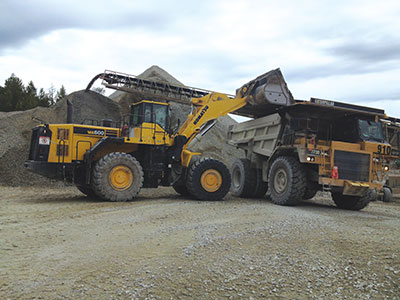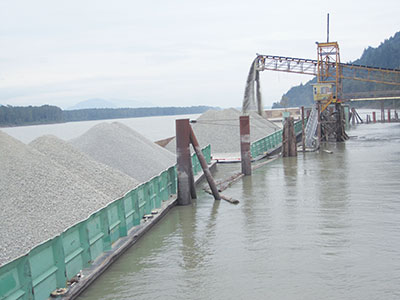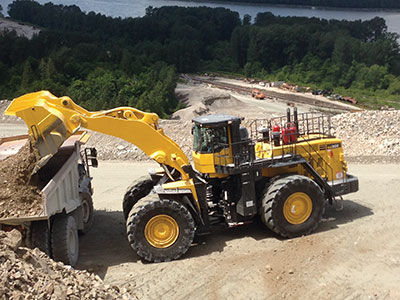
Features
Aggregates
Profiles
Finding Ways to Grow
Mainland continues to find opportunities to grow its operation.
September 25, 2013 By Peter Caulfield
Mainland Sand and Gravel Ltd., based in the Vancouver suburb of Surrey,
started small 43 years ago as a supplier of sand to the regional
construction industry.
Mainland Sand and Gravel Ltd., based in the Vancouver suburb of Surrey, started small 43 years ago as a supplier of sand to the regional construction industry. Since then it has grown to become one of the largest suppliers of aggregate in the Lower Mainland (the region in the southwestern corner of the B.C. mainland that includes and surrounds Greater Vancouver). How Mainland climbed to the top is an interesting story and an example of the importance of focus, tenacity and family loyalty for achieving success in the aggregate business.

|
|
Mainland was founded in 1970 by Laurie Carlson and his brother Mel Carlson. “Laurie was an accountant, and one of his clients had a business that dredged and sold sand from the Fraser River,” says Mainland president Ted Carlson (Laurie’s eldest son). “His client’s son inherited the business, but he didn’t want it and sold it to Laurie.”
In the 1970s, the company realized there was a growing demand for sand, gravel and crushed stone products, and acquired several sand and gravel pits. Because the pits had a limited life span, Mainland started looking for a larger source of raw material that was close to the water, so the company could use barges for transportation.
The two-year search ended in the purchase of a 400-acre site on the Fraser River called Cox Station. Once the necessary permits had been acquired, Mainland built a barge loading facility on the site. The first aggregate shipped from Cox Station, in 1986, was produced from an alluvial deposit of natural sand and gravel. But the deposit was quickly exhausted and in 1987 Mainland began drilling and blasting solid granite at Cox Station. Today, almost all of the material produced at the site is shipped out by barge to the company’s distribution depots along the Fraser River, and direct to customers’ projects. Mainland has shipped more than 16,000 barges of aggregate since 1986.
In 2002, Mainland acquired Jamieson Quarry in Abbotsford, B.C. A land-based quarry, Jamieson ships all of its 100 per cent fractured product by truck. Most of it goes to local markets in Abbotsford, Langley and Surrey.
Mainland produces quarried products, river sand, and recycled concrete and asphalt products. Carlson says Mainland pioneered the use of quarried products in the Lower Mainland in the late 1980s, when most construction-grade aggregates were still produced from alluvial natural sand and gravel deposits.
“Since then, quarried products have gained significant market share in the Lower Mainland,” Carlson says. “In many applications today, quarried products are specified as the only suitable material, because of their superior performance as base gravels.”
Carlson says Mainland’s river sand is used in a variety of applications, such as pre-loads, base on grass playing fields, sub-grade fill, and top dressing sand for golf courses.

|
|
| The Cox Station Quarry includes a 3,500-foot conveyor system to allow for barge loading.
|
“One of the main uses of river sand is pre-loading, because it weighs less than comparable volumes of other sand products, such as bank sand or pit sand,” Carlson says. “River sand consistently weighs between 1.55 and 1.65 tonnes per compacted cubic metre, which gives it a weight advantage of between 10 per cent and 20 per cent over other types of sand. That can add up to big savings, by reducing the number of tonnes required to achieve the desired volume.”
Mainland also supplies recycled concrete and asphalt products from demolitions and repaving projects.
Mainland operates four distribution yards and two producing quarries and produces more than five million tonnes of sand and gravel products per year, which makes it one of the largest suppliers in the Lower Mainland.
The company has a wide variety of customers: Construction job sites, road builders, railways, utilities, contractors, builders of single- and multi-family housing, marine contractors, municipalities, and provincial and federal governments.
Mainland has a large fleet of equipment. The company’s rolling stock includes 13 Caterpillar front-end loaders; one Volvo front-end loader; and five Komatsu front-end loaders. In addition, it has eight Caterpillar rigid-frame trucks, three Caterpillar 740 articulated trucks, one Caterpillar 345 D excavator, one EC 380D Volvo excavator, one EX 1100-3 Hitachi excavator and one PC Komatsu excavator.
The company’s complement of support equipment includes one Caterpillar 14G grader, one Caterpillar 236 skid-steer loader and one Caterpillar Telehandler. Mainland has two drills: one Ingersoll Rand DM45E down-the-hole (DTH) drill and one Sandvik D25 KS DTH drill.
Mainland’s Cox Quarry has three crushing plants equipped with crushers, screen decks and conveyors. It also has a portable crushing plant and wash plant. In addition, Cox has a 3,500-foot conveyor feeding a barge loading system.
At Jamieson Quarry, all the production is contracted out to Pacific Site Concrete.

|
|
| Mainland uses a variety of transportation resources for moving aggregates to its customer base throughout the Fraser Valley. The Jamieson Quarry ships 100 per cent of its aggregate products by truck.
|
Recent equipment purchases include two new Caterpillar 980 H loaders, two new Caterpillar 775G quarry trucks, one new Volvo L35 OF front-end loader, one new Volvo EC380D excavator, one new Komatsu WA900-3 front-end loader, one new Komatsu WA600-6 front-end loader and two new Pacific Industrial Scale portable weigh scales.
Carlson says the reason for the purchases is that during the recession the company didn’t replace much of its older equipment.
“Now we’re catching up and adding new capacity,” he says. “And in the next 12 months, we’ll be looking to buy more equipment, such as articulated trucks, a front-end loader, and crushing, screening and conveying equipment.”
Carlson says Mainland buys, rather than leases, all of its equipment. “It’s the most cost-effective way to finance the purchase of our equipment,” he says.
Mainland has 100 full-time employees: 75 are operators and 25 are management and office staff. Carlson says the company has had no trouble finding employees. “We have a good reputation in the industry,” Carlson says. “In the future, however, it might be harder to find young men and young women to replace staff as they retire.”
The Carlson family is still Mainland’s sole owner. In addition to president Ted Carlson, founder Laurie Carlson is CEO and Laurie’s youngest son, Brent Carlson, is vice-president.
Ted Carlson says what makes Mainland different from its competitors is that it doesn’t compete with its customers by doing contracting or placing work.
“We have grown horizontally rather than vertically, to appeal to as wide a customer base as possible,” he says.
Print this page